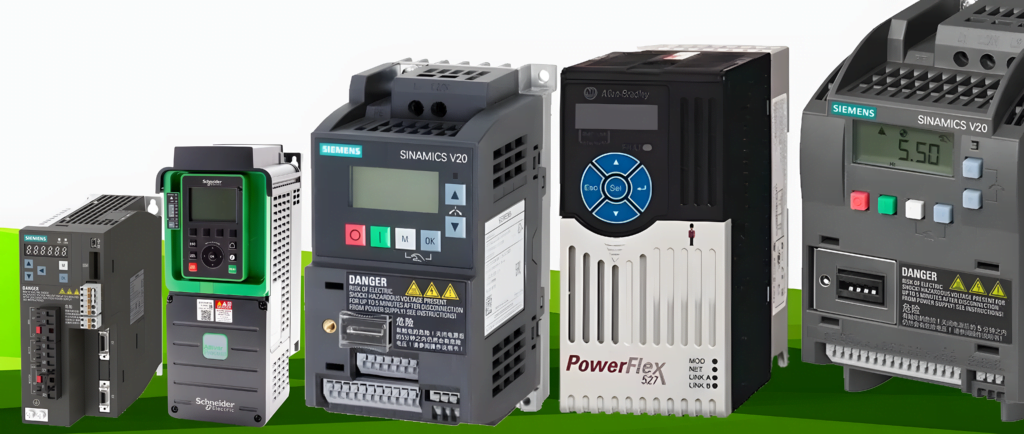Variable Frequency Drive (VFD) – Ribhu International
A variable frequency drive (VFD) is a type of motor control that drives an electric motor by varying the frequency and voltage of the electric current. The VFD also has the ability to control the ramp up and ramp down of the motor during start up or shut down. Although the frequency converter controls the frequency and voltage of the power supplied to the motor, we often call this speed control because the resulting speed of the motor changes.
Frequency (or hertz) is directly related to motor speed (RPM). the faster the frequency, the faster the rotation speed. If the application does not require the electric motor to operate at full speed, the VFD can be used to reduce the frequency and voltage to meet the load requirements of the electric motor. When motor speed is required, the VFD can easily increase or decrease motor speed to meet demand.

Components of VFD
Rectifier
The rectifier serves as the primary component in the VFD, responsible for converting the AC input into DC power supply. It usually consists of a bridge rectifier circuit that rectifies the sinusoidal wave form of alternating current and produces direct current, Diode plays an important role in the rectification process and enables the conversion of AC to DC.
DC bus
The DC bus acts as the central energy storage unit in the VFD. Its primary function is to produce a stable direct current by converting the direct current produced by the rectifier. This unit offers the ability to reduce voltage and provide energy storage capabilities. DC bus capacitance plays an important role in maintaining the DC voltage level.
Inverter
inverter is the main component of VFD, which is responsible for converting the DC voltage from the DC bus into an AC power supply with variable frequency and voltage. It consists of insulated gate bipolar transistors (IGBTs) or metal-oxide semiconductor field-effect transistors (MOSFETs) that switch direct current on and off at high frequencies to produce pulse-width modulated (PWM) signals. The inverter circuit that varies the width of pulses to regulate voltage and output, provides speed control of the motor.
Control Circuit
The control circuitry serves as the intelligence behind the operation of the VFD. It consists of a microprocessor or microcontroller and various sensors and feedback devices. The control circuit receives user input and commands, monitors the speed and operation of the motor, and adjusts the output frequency and voltage accordingly. It also includes security features, error detection mechanisms, and communication interfaces for integration with external systems.
Operator Interface
VFDs include an interface that allows operators to set parameters, monitor performance, and monitor drives. This could be a click, a display, or an intelligent human-to-machine interface (HMI).
Feedback devices
Sensors such as encoders or tachometers provide feedback to the controller about the actual motor speed. This information is used to adjust the output of the VFD to maintain the desired speed.
Braking System
Some VFDs are equipped with a braking system to help stop or accelerate the engine quickly. Depending on the version, this may be a new brake or a used brake.
Cooling System
VFD generates heat during operation and a cooling system is needed to dissipate this heat and protect components from overheating. These may be fans, heaters or other cooling systems.
EMI Filter
An electromagnetic (EMI) filter is used to reduce the electromagnetic noise generated by the VFD and prevent it from affecting other electronic devices.
Working of VFD
The ability of a Variable Frequency Drive (VFD) to control motor speed lies in its ability to vary the frequency and voltage of the power delivered to the AC motor. This allows the motor to operate at different speeds according to demand, increasing performance and flexibility in a variety of applications. The basic function of a VFD is to convert AC input power to DC, then convert it back to AC at variable voltage. The most important components in this process are the rectifier, DC link (or bus) and inverter.
A rectifier converts alternating current (AC) to direct current (DC) using a diode that allows current to flow in one direction. It determines the level of variable energy flow. The DC converter then stores the direct current, concentrates it and prepares it for conversion into alternating current. This unit provides stable power that is ready to change. The last and most important part is the inverter. Direct current is converted back to alternating current using insulated gate bipolar transistors (IGBTs). By varying the frequency of these IGBTs via pulse width modulation (PWM), the AC output frequency controls the motor speed. Fast switching of ac output will increase the speed of the motor and vice versa
controlling the speed of the motor is the ability to set the frequency. By increasing or decreasing the voltage supplied to the AC motor, they enable the motor to operate at different speeds according to need.
Applications of VFD
Elevator and escalator System:
Lifter systems often use VFDs to control the speed of the engine, resulting in better acceleration, deceleration and better ground levelling.
Conveyor Systems:
VFDs are used to control the speed of the motor that drives the belt in conveyor systems. This enables better maintenance of the equipment and can be adapted to production needs.
HVAC Systems:
VFDs are commonly used in heating, ventilation, and air conditioning (HVAC) systems to control the speed of motors that drive fans and pumps. This helps save energy and better control weather and climate.
Pumping System:
VFDs are used in the pumping system to control the pumping speed according to demand. This is particularly useful in water supply systems, water treatment plants and irrigation systems.
Machine Tools:
VFDs play an important role in machine tools by controlling the speed of motors in lathes, grinders, and other processing equipment. This makes the production process simpler and more complete.
Advantages of VFD over SOFT STARTER
Speed Control:
VFDs provide precise control of motor speed not only during startup but throughout operation. Unlike a simple starter that only controls starting and stopping, VFDs allow you to adjust the motor speed as needed.
Energy Efficiency:
VFDs can save energy by matching motor speed to load requirements. They provide significant energy savings by increasing energy efficiency, especially in applications such as fans and pumps.
Reducing motor overheating:
VFD prevents motor overheating by maintaining constant speed and preventing unnecessary power loss. A simple login does not provide a level of control.
Powerful Performance:
VFDs offer more features and functionality than a simple starter. They can provide diagnostic information digitally, making them valuable for troubleshooting and maintenance.
Smooth Ramp-Up and Ramp-Down:
VFDs allow gradual acceleration and Deacceleration, reducing stress and wear on equipment. A soft start also makes for an easy start, but the VFDs are best in this case.
Ease of use:
If the application requires fast operation and start/stop, VFD is the best choice. The soft starter is simple and economical but lacks the ability to regulate speed.
Safety features in VFDs
VFDs often include safety features such as overload protection, overcurrent protection, and other safety measures to protect the motor and connected equipment. These components work together to precisely control the speed and torque of an AC motor, providing energy savings and increased performance in a variety of industrial applications.
- Image
- SKU
- Rating
- Price
- Stock
- Availability
- Add to cart
- Description
- Content
- Weight
- Dimensions
- Additional information







